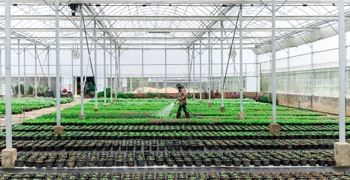Reduce, reuse, recycle…..
With the environment taking centre stage in world politics, everyone is becoming more aware of the impact they are having on the local and global environment. Often a complex area with no simple solutions, Technical Area Sales Manager Andy Hodges highlights several areas where nurseries can play a part in helping to promote the sustainability of our industry.

Horticulture is generally thought of as a ‘green’ industry and, while plants are beneficial to our health and the greater environment as a whole, there are some aspects of ornamental horticultural production that can potentially be deemed negative. So the key is to be aware of these and manage appropriately. Here are a few things to think about when looking at the environmental sustainability of your own set up.
Plastic and pots: In recent years we’ve seen major improvements in the availability of recyclable pots, as well as pots manufactured from recycled materials. Arguably, improvements are still needed within the recycling industry regarding kerbside collections but, hopefully, where horticulture leads local authorities and others will eventually follow. Don’t overlook other sources of plastic. Polythene tunnel skins and ground covers etc can be recycled by companies specialising in the collection of ‘farm’ waste plastic, thereby reducing landfill / incineration.

Pesticides: Greater strides are being made in the use of pathogens, predators and parasites to control pests and diseases on nurseries – obviously, great news for the environment but it is doubtful that horticulture will be totally pesticide free within the foreseeable future.
However, this does not diminish the importance of what is used, how it’s used and disposed of. Generally when a product is withdrawn there is a ’use up’ period - timetabling a date by when manufacturing has to stop, another when it can no longer be sold and finally a date beyond which it can no longer be used.
The basic premise adopted by the Government is that “All pesticides cannot be used, except those registered and approved.” The reason being that it applies to products sold in the UK as well as those brought in from abroad. This means only current UK registered pesticides can be used, in conjunction with the specifics on the label or EAMU. Correct disposal of surplus, outdated or old materials is vitally important. There have been cases where inappropriate disposal has lead to the pollution of waterways and the death of fish. This has resulted in court case and significant fines imposed on those responsible.
Growing media, water and fertilisers:

These three are interlinked so I’ll look at them collectively.
The requirements of a good growing media is to give stability to the plant, while keeping the correct balance of air:water in the rootzone and is capable of holding the right balance of nutrition within an acceptable pH range. For many years peat has dominated, as it naturally offers these factors, or has provided a base that can be easily manipulated.
So, as the industry reduces reliance on peat, we have to ensure plants’ needs are still met.
It is worth considering that some substitutes, or diluents, travel long distances or require major energy inputs during manufacture. Even though their use is appealing, some locally sourced materials can be inconsistent, or at worst potentially harmful. It is also noteworthy that non-peat products often drain more freely, and therefore potentially require more water to be applied. They can have the additional challenges in regard to buffering capacity, which is generally less than peat, creating potential leaching issues.
With pressure for professional horticulture to meet peat-free targets by 2030, a five-year AHDB project (CP138, co-funded by Defra, AHDB and the industry) is looking at the sustainability and environmental impact of materials used in growing media. With research carried out by ADAS, the project is looking at the characteristics of growing media and how these are best fulfilled, using non-peat products. With a final report due in 2020, visitors to our recent Hort Science Live event received an interim update.
No magic bullet
Responsible use of water, fertilisers and pesticides not only make sense from an environmental point of view, but reducing any wastage in these areas also makes financial sense. Helping protect the environment, while saving money, has got to be a sensible plan.
As in many areas of life, there isn’t a magic bullet that can give a ‘one size, fits all’ solution to the challenge of reducing the environmental impact of horticulture. However, there is a mantra that was popular a few years ago “Reduce, Reuse, Recycle” – and it’s still valid today. But, if considering replacing what you are currently using, be sure to ask yourself if the replacement is better from an environmental standpoint?
